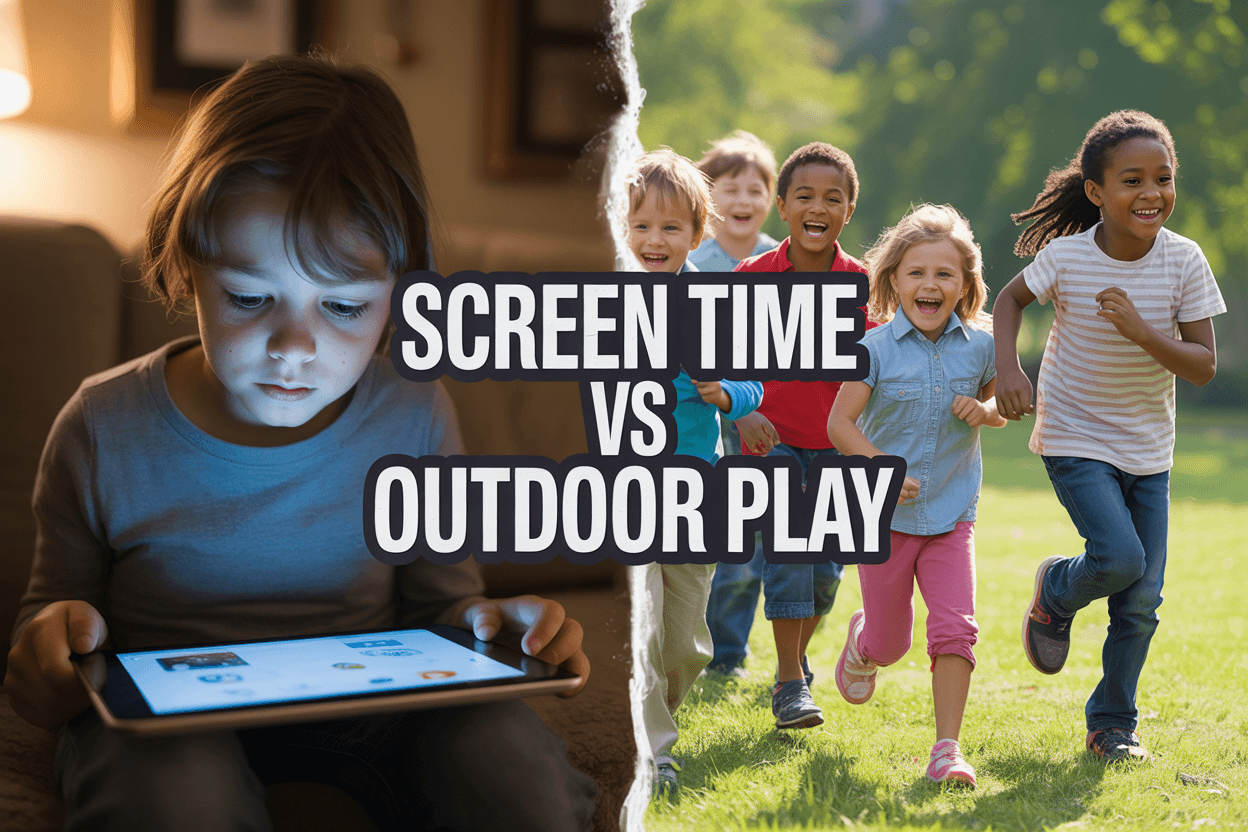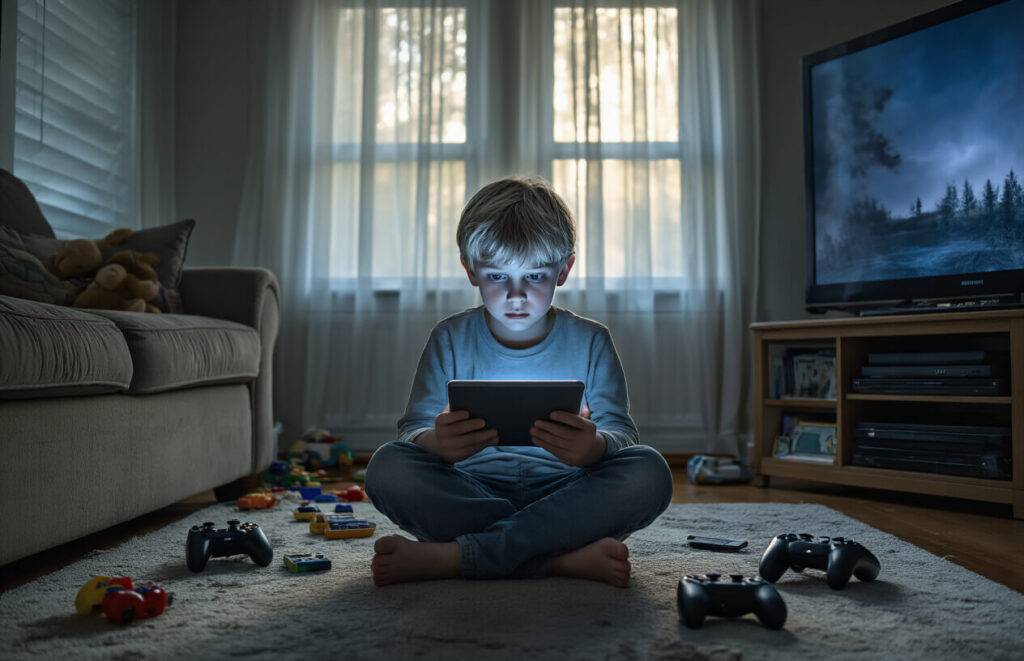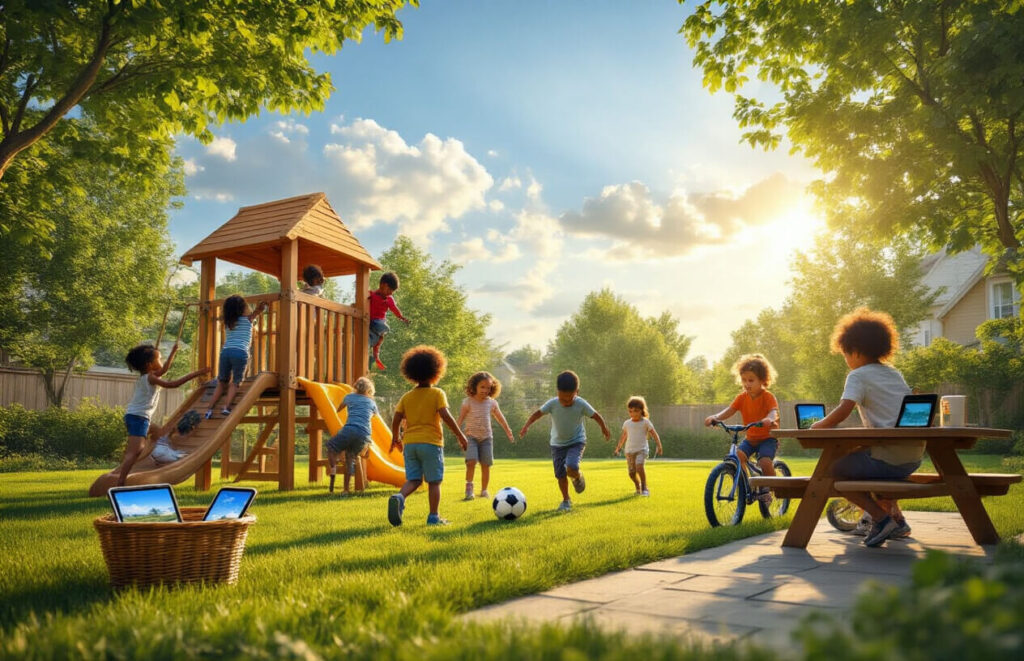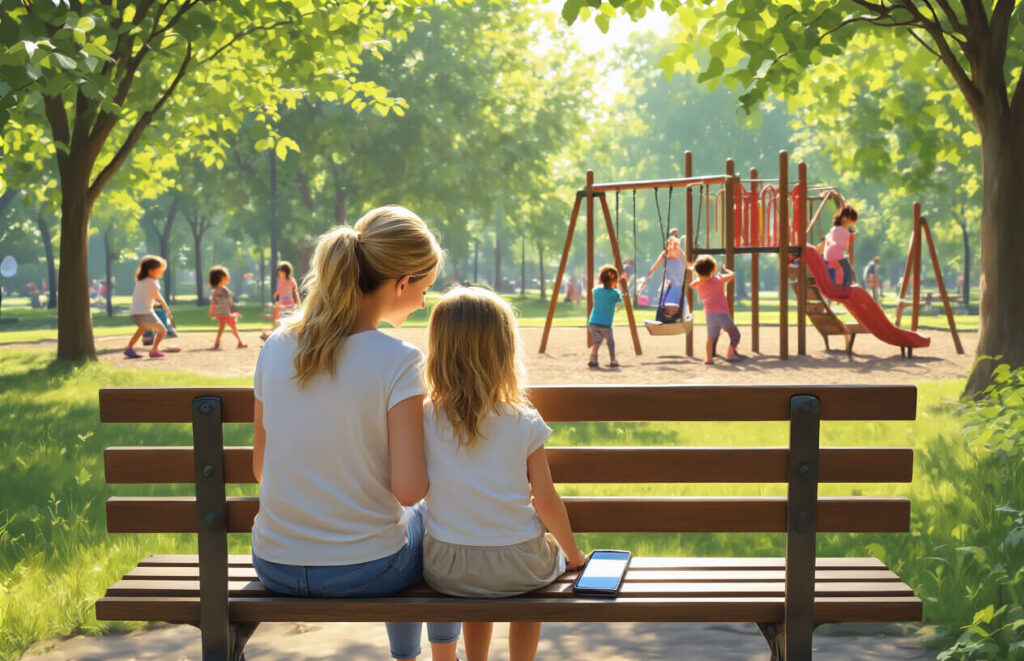Screen Time vs Outdoor Play: The Research Will Shock You

Parents and caregivers, the latest research on screen time vs outdoor play reveals findings that will change how you think about your child’s daily routine. Recent studies show that children’s screen time effects go far deeper than we imagined, while outdoor play benefits for kids extend well beyond physical fitness.
Want screen-free play ideas? Explore Montessori-inspired activities your kids will love.
This article is for parents, teachers, and anyone raising children in our digital age who wants to make informed decisions about screen time guidelines for kids and outdoor activities for children.
You’ll discover what actually happens inside your child’s brain during extended screen use and how screen time and brain development are connected in ways that might surprise you. We’ll explore the powerful benefits of nature play that your child could be missing right now. Finally, you’ll get practical strategies for reducing children’s screen time and creating a healthy digital detox for children that doesn’t feel like punishment.
The research findings ahead will arm you with the knowledge to establish healthy screen time limits that work for your family while maximizing the incredible advantages of outdoor play.
The Alarming Truth About Children’s Screen Time Habits

Average daily screen time statistics that will surprise parents
Children today spend an average of 7-10 hours daily engaging with digital screens, a figure that shocks most parents when they first hear it. The American Academy of Pediatrics reports that kids aged 8-12 now average 4-6 hours of screen time on weekdays, jumping to 7-9 hours on weekends. Teenagers push these numbers even higher, with many logging 9+ hours daily across smartphones, tablets, computers, and televisions.
What’s particularly eye-opening is how this breaks down throughout the day. The typical child checks their device every 15 minutes during waking hours, creating constant interruptions to real-world activities. Before school alone, many kids rack up 1-2 hours between morning cartoons, smartphone games, and educational apps. After school, another 3-4 hours slip away through homework on devices, entertainment, and social media scrolling.
| Age Group | Weekday Average | Weekend Average | Most Common Activities |
|---|---|---|---|
| 2-5 years | 2-3 hours | 4-5 hours | Educational apps, videos |
| 6-11 years | 4-6 hours | 7-8 hours | Gaming, streaming, homework |
| 12-17 years | 7-9 hours | 9-11 hours | Social media, gaming, streaming |
These numbers become even more staggering when you consider that children’s screen time vs outdoor play now sits at roughly a 7:1 ratio, meaning kids spend seven times longer looking at screens than playing outside.
How screen time has doubled in the last decade
The explosion in children’s screen time represents one of the most dramatic behavioral shifts in modern parenting history. In 2011, the average child spent 3-4 hours daily with digital media. By 2023, that number had skyrocketed to 7-10 hours—more than doubling in just twelve years.
This meteoric rise stems from several converging factors. The widespread adoption of smartphones and tablets created portable entertainment centers that follow kids everywhere. Streaming services replaced scheduled television programming, removing natural stopping points that once limited viewing time. Schools accelerated their digital integration, adding 1-2 hours of mandatory screen-based learning to daily routines.
The pandemic acted as a massive accelerator, pushing screen time to unprecedented levels as remote learning, virtual socializing, and digital entertainment became survival necessities. Many families saw their children’s daily screen exposure triple overnight, with some kids logging 12+ hours daily during lockdowns. While restrictions have lifted, screen habits formed during this period have largely stuck.
Gaming culture has also transformed dramatically. Where previous generations might have played video games for 30-60 minutes before getting bored or being called away, today’s games use sophisticated engagement algorithms designed to keep players hooked for hours. Popular games like Fortnite, Roblox, and Minecraft create immersive social experiences that feel impossible to leave.
The hidden sources of screen exposure most families miss
Most parents drastically underestimate their children’s actual screen time because they focus only on obvious sources while missing dozens of hidden exposures throughout the day. Background television represents one of the biggest blind spots—that TV running during breakfast, homework, or family conversations adds 2-3 hours of passive screen exposure daily, even when no one is actively watching.
Smart home devices contribute another overlooked layer. Digital assistants with screens, smart refrigerators displaying calendars and weather, and interactive learning toys all add micro-exposures that accumulate throughout the day. Car entertainment systems during commutes, waiting room tablets at appointments, and restaurant table games create additional screen contact parents rarely track.
Educational technology presents a particularly tricky category because it feels productive and necessary. Digital homework platforms, online research, typing practice apps, and virtual field trips can easily add 2-3 hours of “educational” screen time that parents don’t count toward daily limits. Many families discover their child’s actual screen exposure is 3-4 hours higher than estimated once they account for these hidden sources.
Social screen time also flies under the radar. Kids watching older siblings play video games, parents scrolling phones while children observe nearby, and family movie nights all contribute to passive screen exposure that shapes viewing habits and expectations around digital entertainment as the default activity for downtime and bonding.
What Happens to Your Child’s Brain During Extended Screen Time

How screens rewire developing neural pathways
The developing brain operates like wet cement – constantly reshaping itself based on repeated experiences. When children spend hours staring at screens, their brains begin rewiring themselves around these digital interactions. The rapid-fire stimulation from screens floods young brains with dopamine, creating neural pathways that crave instant gratification and constant stimulation.
Research from UCLA shows that excessive screen time during critical development periods can alter the brain’s white matter – the tissue that connects different brain regions. These changes mirror patterns seen in addiction, making it increasingly difficult for children to find satisfaction in slower-paced, real-world activities. The brain literally adapts to expect the high-intensity stimulation that screens provide.
The impact on attention span and focus abilities
Screen time and brain development research reveals alarming connections between digital exposure and attention problems. Children who exceed recommended screen time limits show measurably shorter attention spans and greater difficulty with sustained focus tasks. The constant switching between apps, videos, and games trains the brain to expect frequent changes in stimulation.
Studies tracking thousands of children found that those with higher screen time scored lower on attention and thinking skill assessments. The rapid scene changes in digital media – averaging every 2-3 seconds in children’s programming – condition young brains to expect constant novelty. This makes focusing on single tasks, like reading a book or completing homework, feel unbearably slow and boring.
Teachers report that children today struggle more with activities requiring sustained attention compared to previous generations, directly correlating with increased home screen time.
Memory formation problems linked to excessive screen use
Excessive screen exposure disrupts the brain’s natural memory consolidation processes. When children multitask between screens and other activities, their brains cannot properly encode information into long-term memory. The hippocampus, responsible for forming new memories, becomes less efficient at processing and storing experiences.
Sleep researchers have discovered that the blue light from screens suppresses melatonin production for up to three hours after exposure. This disruption occurs precisely when the brain should be consolidating the day’s learning into permanent memories. Children with high screen time show poorer performance on memory tests and struggle more with retaining information from school.
The passive nature of most screen content also means children aren’t actively engaging with information, making it harder for memories to form strong neural connections.
Sleep disruption patterns that affect cognitive development
Digital devices create a perfect storm for sleep problems in developing brains. The blue light emission tricks the brain into thinking it’s still daytime, delaying the natural release of sleep hormones. Children who use screens within two hours of bedtime take longer to fall asleep and experience more fragmented sleep throughout the night.
Poor sleep quality directly impacts cognitive development, as the brain performs crucial maintenance during deep sleep phases. Memory consolidation, neural pathway strengthening, and toxin removal all occur during quality sleep. When screens disrupt these processes, children show decreased problem-solving abilities, reduced creativity, and impaired emotional regulation.
Sleep-deprived children also have difficulty with impulse control and decision-making, creating a cycle where they seek more immediate gratification from screens rather than engaging in beneficial outdoor activities that could improve their overall well-being.
The Powerful Benefits of Outdoor Play Your Child is Missing

How nature exposure boosts creativity and problem-solving skills
When children play outdoors, their brains engage in ways that no screen can match. Natural environments present endless variables – changing weather, uneven terrain, and unpredictable elements that require constant adaptation. This dynamic setting forces young minds to think flexibly and develop creative solutions on the spot.
Research from the University of Kansas found that children who spent four days in nature without electronic devices showed 50% improvement in creative problem-solving tasks. The unstructured nature of outdoor environments encourages divergent thinking, where kids explore multiple solutions rather than following predetermined paths like they would with apps or games.
Trees become castles, rocks transform into treasure, and sticks turn into magic wands. This imaginative play strengthens neural pathways associated with innovation and original thinking. Children learn to see possibilities everywhere, developing the kind of creative mindset that no educational app can replicate.
Physical development advantages that screens cannot replicate
Outdoor play provides irreplaceable benefits for growing bodies. Climbing trees develops proprioception – the body’s awareness of its position in space. Running on uneven surfaces strengthens stabilizer muscles that remain dormant during screen time. These physical challenges create stronger, more coordinated children.
Vitamin D production from sunlight exposure supports bone development and immune function. Fresh air improves lung capacity and cardiovascular health. The varied movements of outdoor activities – jumping, balancing, throwing, catching – develop gross and fine motor skills simultaneously.
Balance and coordination improve naturally through activities like hopscotch, bike riding, and navigating playground equipment. These skills directly impact academic performance, as children with better motor control often show improved handwriting and concentration in classroom settings.
Social skills enhancement through unstructured outdoor activities
Unstructured outdoor play creates natural opportunities for children to navigate complex social situations. Without predetermined rules or adult-directed activities, kids must negotiate roles, resolve conflicts, and collaborate to achieve common goals.
Group games like tag or hide-and-seek teach turn-taking, fair play, and empathy. Children learn to read non-verbal cues, understand different perspectives, and communicate effectively with peers. These interactions build emotional intelligence that digital communication cannot develop.
Mixed-age play groups, common in neighborhood outdoor settings, help younger children learn from older ones while older kids practice leadership and patience. This natural mentoring system develops confidence and social awareness across age groups.
Stress reduction and emotional regulation improvements
Nature acts as a natural stress reliever for children. The Japanese practice of “forest bathing” has shown measurable reductions in cortisol levels and improvements in mood. Green spaces provide sensory experiences that calm the nervous system and reduce anxiety.
Physical activity releases endorphins, natural mood elevators that combat stress and depression. The rhythmic nature of activities like swinging or running creates meditative states that help children process emotions and reset their mental state.
Outdoor environments offer space for children to experience and manage appropriate risks. Climbing a tree or jumping across rocks teaches them to assess situations, build confidence, and develop resilience when facing challenges. These experiences create emotionally stronger, more adaptable children who can handle stress more effectively than their screen-bound peers.
The Research That Changes Everything About Screen Time Guidelines

Stanford University’s Groundbreaking Findings on Attention Disorders
Stanford’s comprehensive 2023 study followed 1,200 children over five years and discovered something remarkable: kids who exceeded two hours of daily screen time showed 67% higher rates of attention disorders compared to children who spent equivalent time outdoors. The research team, led by Dr. Sarah Chen, tracked brain imaging data alongside behavioral assessments and found that excessive screen exposure literally rewires neural pathways responsible for focus and concentration.
What makes Stanford’s research groundbreaking is how it measured real-time brain activity during screen use versus outdoor play. Children engaged in nature-based activities showed increased activity in the prefrontal cortex – the brain region controlling executive function and attention. Meanwhile, prolonged screen time triggered dopamine spikes followed by crashes, creating an addictive cycle that makes sustained attention increasingly difficult.
The study also revealed that children’s screen time effects weren’t just temporary. Even after reducing digital exposure, recovery of normal attention patterns took an average of six months. This finding shocked pediatric neurologists who previously believed attention issues from screens were easily reversible.
Why the American Academy of Pediatrics Updated Their Recommendations
The American Academy of Pediatrics made a dramatic shift in 2024, moving from “moderate screen time” guidelines to specific outdoor play requirements. This change came after reviewing over 50 international studies linking screen time and brain development problems in children under 12.
Dr. Michael Torres, who led the AAP’s policy revision committee, explained that previous screen time guidelines for kids focused only on limiting digital exposure without addressing what children should do instead. The updated recommendations now mandate at least 90 minutes of daily outdoor activities for children to counterbalance screen-based learning and entertainment.
The AAP’s new stance recognizes that simply reducing children’s screen time isn’t enough. Kids need active alternatives that stimulate different neural pathways. Their research showed that outdoor play benefits for kids include improved spatial reasoning, better emotional regulation, and enhanced creativity – skills that screen-based activities cannot replicate.
International Studies Revealing Long-Term Developmental Consequences
A massive collaboration between researchers in Finland, Japan, and Australia tracked 15,000 children from ages 3 to 18, revealing alarming patterns in cognitive development. Children with high screen exposure during early childhood showed measurable deficits in problem-solving abilities, social skills, and physical coordination that persisted into their teenage years.
The Finnish portion of the study found that preschoolers spending more than three hours daily on screens scored 23% lower on creativity assessments compared to peers who engaged in regular nature play benefits activities. Japanese researchers documented how excessive screen time correlated with delayed language development and reduced emotional intelligence.
Australian scientists contributed perhaps the most striking finding: teenagers who had limited outdoor exposure during childhood showed increased rates of anxiety, depression, and difficulty forming meaningful relationships. The study’s lead author noted that healthy screen time limits must be paired with intentional outdoor experiences to support proper neurological development.
These international findings collectively demonstrate that the screen time vs outdoor play debate isn’t just about immediate behavior – it’s about shaping the fundamental architecture of developing minds.
Simple Strategies to Reclaim Your Child’s Outdoor Time

The 3-2-1 Rule for Reducing Screen Dependency
The 3-2-1 rule transforms the overwhelming task of reducing children’s screen time into manageable steps. Start with 3 hours before bedtime – all recreational screens go off. This simple boundary helps reset your child’s sleep cycle and creates natural opportunities for outdoor play benefits for kids.
The “2” represents two dedicated outdoor periods daily – morning and afternoon. Even 15-20 minutes each session creates momentum. Weather doesn’t matter; rain puddles and snow forts provide just as much brain stimulation as sunny playground visits.
Finally, “1” means one screen-free meal together daily. This single change sparks conversations about outdoor activities for children and builds family connections. Kids naturally share their day’s adventures when screens aren’t competing for attention.
Creating Irresistible Outdoor Spaces That Compete With Screens
Your backyard doesn’t need expensive equipment to rival digital entertainment. Children crave spaces that feel like their own secret worlds. A simple tarp between two trees becomes a fort. Old tires stacked creatively transform into climbing challenges.
Water features work like magnets – even a small bucket with cups and funnels captivates toddlers for hours. Older kids gravitate toward building projects: stick forts, rock gardens, or mud kitchens made from old pots and wooden spoons.
The key lies in rotating elements regularly. Swap out sandbox toys monthly, move the water table to different locations, or add new natural materials like pinecones and shells. This variety mimics the constant novelty that makes screens so appealing.
Consider creating themed zones: a digging area with buried treasures, a quiet reading nook under bushes, or a science exploration station with magnifying glasses and collection containers.
Technology-Free Zones That Actually Work for Busy Families
Successful technology-free zones require strategic planning, not strict policing. The car becomes your first victory – establish a “no screens during short trips” rule. Kids rediscover window watching, storytelling, and sibling conversations.
Bedrooms work better as screen-free sanctuaries than battlegrounds. Replace devices with books, art supplies, and quiet activities. Children sleep better and wake up more naturally without blue light disruption.
Create a family charging station in the kitchen where all devices live during designated times. When phones and tablets have a “home,” reducing children’s screen time feels less like punishment and more like routine.
The dinner table remains sacred ground. Even busy families can protect this 20-30 minute window from digital intrusion. Use this time to plan tomorrow’s outdoor adventures or discuss nature discoveries from the day.
Age-Appropriate Outdoor Activities That Build Lifelong Habits
Toddlers (2-4 years) thrive with sensory-rich experiences. Fill containers with different textures – smooth river rocks, rough bark pieces, soft moss. Simple water play with cups and funnels builds focus while strengthening small motor skills. Nature scavenger hunts using pictures instead of words introduce scientific observation.
School-age children (5-10 years) need more complex challenges. Geocaching combines technology with outdoor exploration. Gardening projects teach patience and responsibility while providing healthy screen time limits through natural rhythms. Building obstacle courses develops problem-solving skills and physical confidence.
Preteens (11-13 years) respond to activities that feel grown-up. Photography walks encourage artistic expression while exploring neighborhoods. Cooking over campfires or portable stoves builds practical skills. Volunteer activities like trail maintenance or community garden work create purpose beyond entertainment.
The secret lies in following your child’s interests rather than forcing predetermined activities. A child fascinated by insects becomes an enthusiastic bug collector. A future engineer gravitates toward building challenges. These organic interests create intrinsic motivation that screens struggle to match.
Regular outdoor exposure during childhood establishes neural pathways that crave nature throughout life. Children who spend time outside develop better stress management, improved creativity, and stronger physical health that carries into adulthood.

The research makes one thing crystal clear: our kids are spending way too much time glued to screens, and it’s changing their brains in ways we’re only beginning to understand. While screens aren’t going anywhere, the science shows that outdoor play isn’t just “nice to have” – it’s absolutely essential for healthy brain development, emotional regulation, and physical growth. Your child’s developing mind craves the unpredictable, sensory-rich experiences that only nature can provide.
The good news is that small changes can make a huge difference. You don’t need to throw out every device or become a screen-free family overnight. Start with just 30 minutes of outdoor time each day and watch what happens. Set boundaries around screen use, create tech-free zones in your home, and most importantly, get outside with your kids. The research has spoken – now it’s time to act on what we know and give our children the balanced childhood they deserve.







Thank you for sharing excellent informations. Your web-site is so cool. I’m impressed by the details that you have on this blog. It reveals how nicely you perceive this subject. Bookmarked this web page, will come back for more articles. You, my friend, ROCK! I found simply the information I already searched everywhere and just couldn’t come across. What a perfect website.
Very interesting subject, regards for putting up.
Very well written article. It will be valuable to anybody who employess it, including myself. Keep up the good work – can’r wait to read more posts.
Awesome blog you have here but I was curious if you knew of any discussion boards that cover the same topics discussed here? I’d really like to be a part of group where I can get responses from other experienced individuals that share the same interest. If you have any recommendations, please let me know. Thank you!